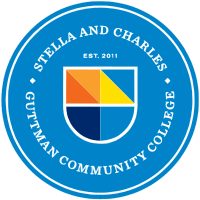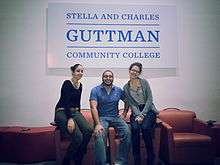Guttman Community College
 | |
Former names | New Community College |
|---|---|
| Type | Public community college |
| Established | 2011 |
| President | Scott E. Evenbeck |
| Provost | Howard Wach |
Academic staff |
|
| Students | 995 (as of Fall 2016)[1] |
| Location |
New York City, New York, United States 40°45′10″N 73°59′03″W / 40.7529°N 73.9841°WCoordinates: 40°45′10″N 73°59′03″W / 40.7529°N 73.9841°W |
| Campus | Urban |
| Affiliations | City University of New York |
| Website |
www |
Stella and Charles Guttman Community College is the newest of City University of New York's (CUNY) seven community colleges. Located at 50 West 40th Street in Midtown Manhattan, New York City, it was founded on September 11, 2011 and opened on August 20, 2012 as New Community College. In April 2013 the college was renamed following a $15 million endowment from the Stella and Charles Guttman Foundation.
Guttman offers 2-year associate degree programs with majors in liberal arts, business, social work, information technology (IT), and urban studies. Students are accepted with either a high school diploma or Certificate of High School Equivalency. The school uses the city as an outdoor, hands-on classroom. Instead of remedial classes, it requires first-year students to take a course called “City Seminar,” which blends math, reading, and writing into lessons about sustainability and immigration in New York.
History

Guttman was the first new community college established by City University of New York (CUNY) in over 40 years. The planning was begun in 2008 on the initiative of CUNY's Chancellor at the time, Matthew Goldstein. The planning phase was supported by CUNY funds, an initial allocation $8.9 million from the City of New York's annual budget, and donations from the Bill and Melinda Gates Foundation and Michael Bloomberg's Center for Economic Opportunity.[2][3] Described by The New York Times as "a multimillion-dollar experiment in how to fix what ails community colleges," Guttman College's academic structure and curriculum were designed from scratch in an effort to improve students' chances of completing their associate degrees and transferring to four-year colleges for further study.[4]
In 2010, the first faculty were appointed and Scott E. Evenbeck, professor of psychology and dean of University College at Indiana University-Purdue University, was named the founding President, taking up his post in January 2011.[5] The college was officially established on September 11, 2011 and opened with its first intake of students in August 2012. The college had, and continues to have, an open admissions policy, provided students have a high school diploma or a Certificate of High School Equivalency. However, unlike any of the other schools within CUNY, applicants are not considered until they have attended a lengthy information session and one-on-one interviews with counselors. Of its initial 4,000 applicants, 504 went through the information session and interviews. Of those, approximately 300 decided to enroll in the founding class.[4][6]
The college opened under the name "New Community College." In April 2013 following the gift of a $15 million endowment from the Stella and Charles Guttman Foundation, one of the largest ever donations to a public two-year college, the CUNY Board of Trustees passed a resolution renaming the college "Stella and Charles Guttman Community College."[7]
History Highlights: · January 2011: President Scott E. Evenbeck appointed as the Founding President
· May 2011: College planning team moved to Guttman’s present location at 50 West 40th St.
· September 2011: The New Community College at CUNY was established by CUNY Board of Trustees. College was CUNY’s first new community college in 40 years
· Fall 2012: 289 students enrolled in the College’s inaugural class
· April 2013: CUNY received $25 million gift from the Stella and Charles Guttman Foundation to support The New Community College and other community college initiatives. Largest gift ever given to a New York State community college
· April 29, 2013: CUNY Board of Trustees passed a resolution to rename The New Community College: the Stella and Charles Guttman Community College[7]
· August 27, 2014: College’s inaugural commencement held
Innovative Model
Opening its doors in August 2012, Stella and Charles Guttman Community College offers associate degree programs as part of an innovative model with an emphasis on experiential education, the adoption of learning communities and instructional teams, and a strong value placed on being simultaneously “high tech” and “high touch.” The College provides a supportive environment that nurtures student success with the goal to increase the graduation rate for our students, many of whom are the first in their family to attend college. All students begin in the required Summer Bridge Program and engage full-time in a city-centered first-year experience before starting their major coursework in one of five degree programs. Instructional teams comprising faculty members, student success advocates, graduate coordinators, peer mentors and library staff create a rich classroom environment complemented by an integrated advisement program to help students stay on the path to graduation.
Educational Model Highlights:
- A multi-step comprehensive admissions process with prospective students.
- A mandatory Summer Bridge Program for incoming students before the start of the Fall semester.
- All first-year students are required to attend on a full-time basis and are grouped in learning communities to foster collaboration, teamwork, and peer accountability.
- Structured core curriculum; no choice of courses in first year.
- No remedial courses; developmental support is built into the curriculum.
- Longer academic calendar; 18-week semesters keep students in school September through July to remain on track to complete their studies.
- Peer Mentors, Student Success Advocates, Career Strategists, and Graduate Coordinators support students academically, professionally, and personally.
- Limited number of “majors” with well-defined pathways to degree, transfer and/or careers: Business Administration (A.A.); Human Services (A.A.); Information Technology (A.A.S.); Liberal Arts & Sciences (A.A.); Urban Studies (A.A.).
- Partnership with a new Early College High School with tracks for Information Technology and Health Information Technology programs.
Results so far:
- Three-year graduation rate of 49% of inaugural class exceeded the goal of 35% set when the College opened in 2012. This rate is significantly higher than the two-year national graduation rate at Large City two-year colleges (14%, IPEDS Graduation Rate Survey 2013[8]). By January 2017, 52% of the inaugural class have graduated.
- Two-year graduation rate of 30% for the 2013 entering cohort. This rate is significantly higher than the two-year national graduation rate at Large City public two-year colleges (4%, IPEDS Graduation Rate Survey 2013[8]).
References
Notes
- 1 2 Guttman Community College. Fast Facts. Retrieved 9 July 2017.
- ↑ Iasevoli, Brenda (27 October 2010). "A New CUNY Community College Is Opening in 2012". The Village Voice. Retrieved 5 December 2013.
- ↑ Santora, Marc (26 January 2009). "CUNY Plans New Approach to Community College". New York Times. Retrieved 5 December 2013.
- 1 2 Pérez-Peña, Richard (20 July 2012). "The New Community College Try". New York Times. Retrieved 5 December 2013.
- ↑ City University of New York press release (22 July 2010). "Dr. Scott E. Evenbeck Named Founding President Of The City University of New York’s New Community College". Retrieved 5 December 2013.
- ↑ Guttman Community College. Stella and Charles Guttman Community College: A Timeline. Retrieved 5 December 2013.
- 1 2 Kaminer, Ariel (29 April 2013). "$15 Million Gift and New Name for Community College". New York Times. Retrieved 5 December 2013.
- 1 2 https://nces.ed.gov/pubs2014/2014067.pdf
Further reading
- Alexandra Weinbaum, Camille Rodríguez, Nan Bauer-Maglin (February 2013). Rethinking Community College for the 21st Century. Case study funded by the Bill and Melissa Gates Foundation for the New Community College at CUNY.